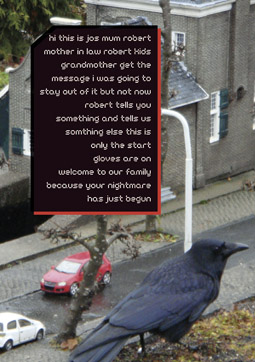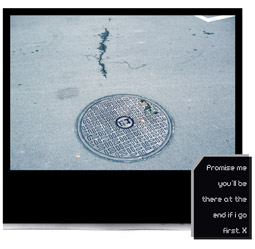d emoshnl pwr of d txt msg
jeremy weinstein: larissa hjorth, cu: the presence of co-presence

from CU The Presence of Co-Presence, Larissa Hjorth
courtesy the artist
from CU The Presence of Co-Presence, Larissa Hjorth
WE AL KNO HW 2 RIT N RECEV TXTS, ITS JST LIK MAKN A FONE CAL. BT SOM SMSS R MOR IMPRTNT THN OTHRS, LIK MST THNGS IN LIF, SOM MSGS STIL PACK A HEVY EMOSHNL PNCH
Larissa Hjorth’s CU: The Presence of Co-Presence explores the phenomenon of the Short Message Service or SMS from its humble origins as a means of communication for the deaf to a staple form of interaction amongst the growing number of ‘thumb tribes.’ The show is presented on CCP’s Night Projection Window; its translucent glass allows images to be viewed from either side. The exhibition takes the form of a 30-minute presentation that combines text messages with photographic images. The messages are not displayed for very long and are rear projected, so the best place to view the exhibition is from the footpath (or better still from the pub across the road).
The interesting thing about a work best viewed from outside the gallery is that the very exhibition becomes an embodiment of co-presence. Going to a photographic gallery only to stand out the front feels like being both there and not there, simultaneously inside and out. The text message also exemplifies this notion—the sender is present with the reader, yet still physically in the location whence the message was sent.
The text messages that Hjorth chose for the exhibition were compiled from those people had saved to their phones. Accounts of the emotions embodied in the messages were also provided to Hjorth by the recipients. From that, individual photographs were created and selected by the artist as a way to capture the emotional significance of each message.
In displaying these still photographic images as ‘moving’, the artist has the luxury of employing techniques like zooms and pans, to take the audience’s eye to areas of interest or significance. Some photographs appear at first as close-ups until zoomed out to reveal different stories. This was most memorable with the photograph accompanying the SMS “I want 2 C U”, which started with a close-up of a man and a woman in an embrace, then slowly pulled out to reveal them as part of a billboard advertising mobile internet.

from CU The Presence of Co-Presence, Larissa Hjorth
courtesy the artist
from CU The Presence of Co-Presence, Larissa Hjorth
While the title of the show CU is a reference to the SMS shorthand of ‘see you’, when photographs start with a distorting close-up (CU, in film shorthand) another aspect of co-presence reveals itself—being in one place but seeing it from two different perspectives. A similar effect was achieved with a pan across the photograph accompanying the message “Promise you’ll be there at the end if i go first. X”, which tracked an oil filled crack as it snaked towards a manhole. These techniques also added another dimension to the emotional impact of the photographs, drawing our attention to details we ordinarily might not notice.
Accompanying the video display is an exhibition catalogue of short essays and creative pieces reflecting and expanding on the evolution and significance of the text message. Giles Lane looks at how closely linked the current Twitter craze is to the popularity of texting, while Darren Tofts pays homage to Alexander Graham Bell for inventing the telephone, the forerunner to SMS and other forms of co-presence.
Texting has become so ubiquitous because it provides people with another, possibly more intimate, way of communicating than speaking into the telephone. Sometimes there are things people would rather not say out loud, whether they are in a public place and do not want to broadcast their message or perhaps because it is so deeply personal they would rather not utter the words at all. This phenomenon has led to people saving certain messages, as they would love letters, to reread and remember forever…or at least until they get new phones.
Ultimately CU is more about the text message than the photography, however the conversation Hjorth develops between the two creates a real sense of the emotional importance that messages of any kind can have on a recipient. As Fee Plumley writes in the catalogue, it’s like the feeling you experienced when you received an affectionate note passed to you by someone in your high-school class.
Hjorth’s exhibition highlights a modern phenomenon that has captured the hearts and minds of millions of users—one is my 90-year old grandmother, Oma, who has not only taken to texting but has also embraced the shorthand that goes along with it. I’m still surprised every time my phone beeps with a message from her and even laugh out loud when I read it: “r u ok? hope 2 c u soon <3 om.”
Larissa Hjorth, CU: The Presence of Co-Presence. Centre for Contemporary Photography, June 5-Aug 1, www.ccp.org.au
RealTime issue #92 Aug-Sept 2009 pg. 34






